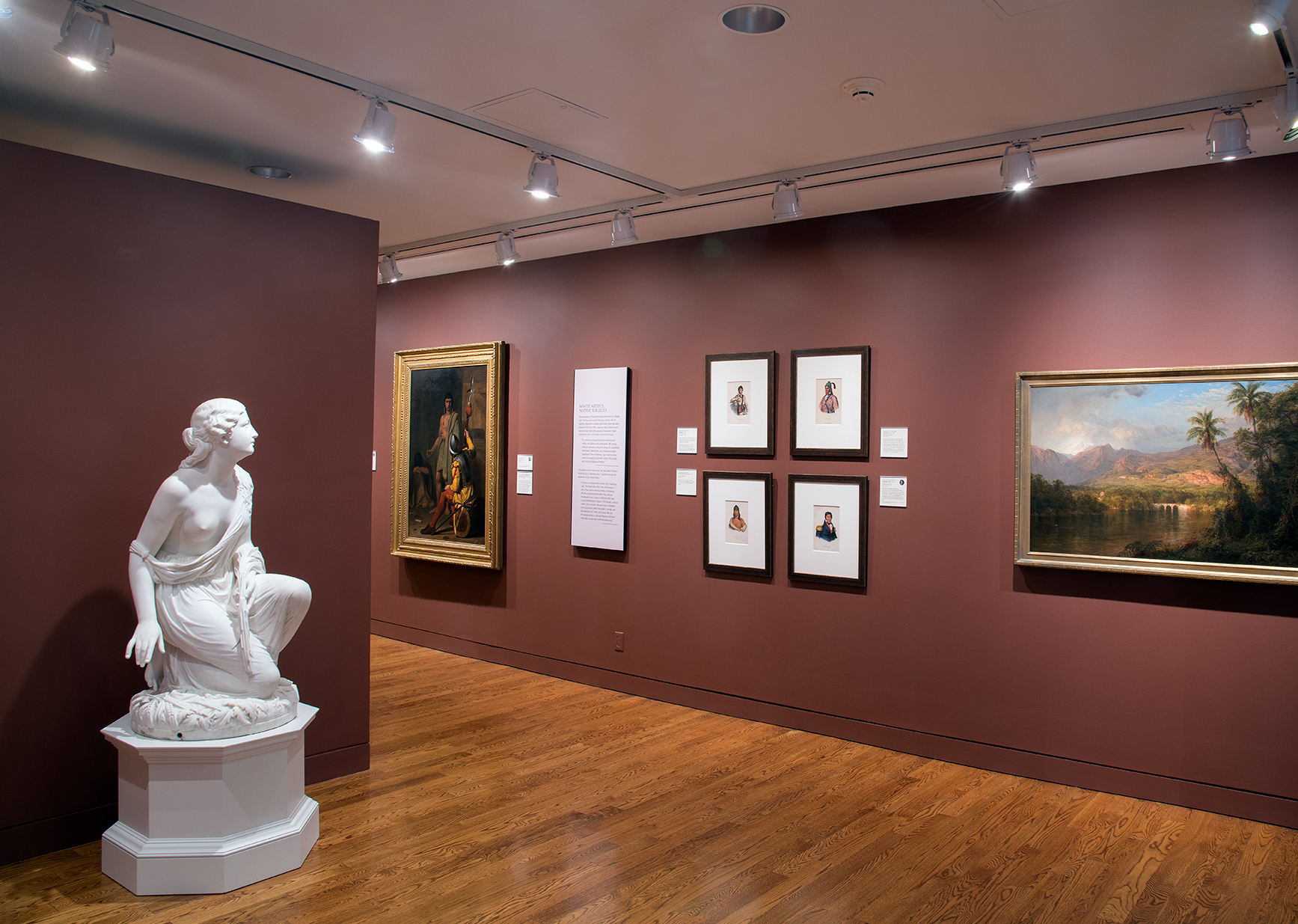I had the pleasure of leading two “Inside Look” gallery talks at the Delaware Art Museum this September on Randolph Rogers’s sculpture Ruth Gleaning (c.1850). Museum visitors and I were fortunate to have the opportunity to gather in-person to discuss Rogers’s work, in the Museum’s recently reimagined American art galleries. As a graduate student studying nineteenth-century American art—and the artworks of Rogers in particular—I was thrilled to interact with Museum visitors and spend time looking closely at the sculpture. Together, we discussed the narrative depicted, Rogers’s practice abroad, and the technical aspects of carving marble. More broadly, examining Ruth led us to consider evolving tastes in American sculpture, and why Rogers’s work was exceptionally admired in the nineteenth century.
Ruth Gleaning illustrates a story from the Book of Ruth in the Old Testament. A Moabite widow, Ruth accompanied her mother-in-law Naomi, also a widow, to Bethlehem. Searching for food after they arrive, Ruth resorts to picking remnants of grain from the recently harvested field of Boaz, a wealthy landowner. Boaz spots Ruth and goes to see her, inviting her to continue to harvest in his fields. Taken by Ruth’s selflessness, loyalty, and beauty, Boaz falls in love. The two eventually marry and have a son named Obed, an ancestor of David.
Rogers’s sculpture depicts the moment when Ruth meets Boaz for the first time. Crouched on the floor with wheat in her arms, Ruth pauses her labor and looks up at her future husband. Although many other sculptors portrayed Ruth, Rogers distinctively captured a fleeting moment of heightened emotional tension, allowing viewers to connect with his subject in new ways.
Rogers travelled to Florence in 1847 to study with the Italian Neoclassical sculptor Lorenzo Bartolini. He modeled Ruth in clay in 1850, shortly before he set up his studio in Rome in 1851. Ruth Gleaning was his first important work and secured his place within a colony of American artists working in Italy. Rome offered American sculptors unparalleled resources: training by Italian artists, access to marble, collections of classical works of art, and trained artisans. For Rogers, the latter was essential; like many of his fellow countrymen, Rogers did not know how to carve marble. He relied on skilled workmen to execute his designs in stone. His studio functioned almost like a factory, with teams of artisans responsible for each component of the sculpting process. As a result, Rogers was able to produce as many as fifty copies of Ruth Gleaning over the course of his career.
As museumgoers and I began to look closely at the sculpture, we noticed its technical sophistication. One participant pointed to the realism of Ruth’s toes, which appear curled to bear the weight of her pose. Another identified the convincing way in which Rogers had rendered her hair, which cascades over her left shoulder, as well as the foliage below her feet. The drapery was notable, too, imbued with a sense of weight and naturalism that revealed the contours of Ruth’s body. We discussed how Rogers was known for combining elements of realism and neoclassicism, the prevailing style at the time. Details like her idealized facial features, partial nudity, and drapery derived from the antique. Rogers drew upon classical sculptures like Crouching Venus for his composition, utilizing local collections in Rome to his advantage.
Most striking to museum visitors was Rogers’s proficiency as a storyteller. Folded over like the wheat she holds, Ruth’s pose corresponded to the nineteenth-century ideology of “true womanhood,” which related a woman’s virtue to submissiveness, humility, and domesticity. Interestingly, many of Rogers’s patrons were women, who ordered sculptures like Ruth Gleaning to reclaim control over and redomesticate their homes in the years following the Civil War. Statues like Ruth Gleaning were not only markers of wealth and status but also reflections of the virtuousness of their owners. As tastes in sculpture changed and the New Woman movement emerged in the 1880s, however, such ideals were threatened. Indeed, by the early 1900s, Rogers’s sculpture had found its way into a popular tourist destination in New York City: an Italian restaurant named Mama Leone’s.
Now on view at the Delaware Art Museum, the sculpture can be seen in a new light once again. Carved in Rogers’s studio in Rome, Ruth crossed the Atlantic to the United States, taking on new meanings over the course of the sculpture’s life. As museumgoers and I examined Ruth Gleaning, we began to uncover the many ways in which Rogers’s sculpture continues to tell stories even today.
Kristen Nassif
Ph.D. Candidate, Art History, University of Delaware
Ruth Gleaning, c. 1850. Randolph Rogers (1825–1892). Marble, 47 × 26 × 26 inches, base: 20 × 28 × 28 inches. Private Collection, Delaware, Courtesy of Art Finance Partners, LLC. Installation image of Picturing America (American Art through 1900), 2021. Photograph by Carson Zullinger. © Delaware Art Museum.

